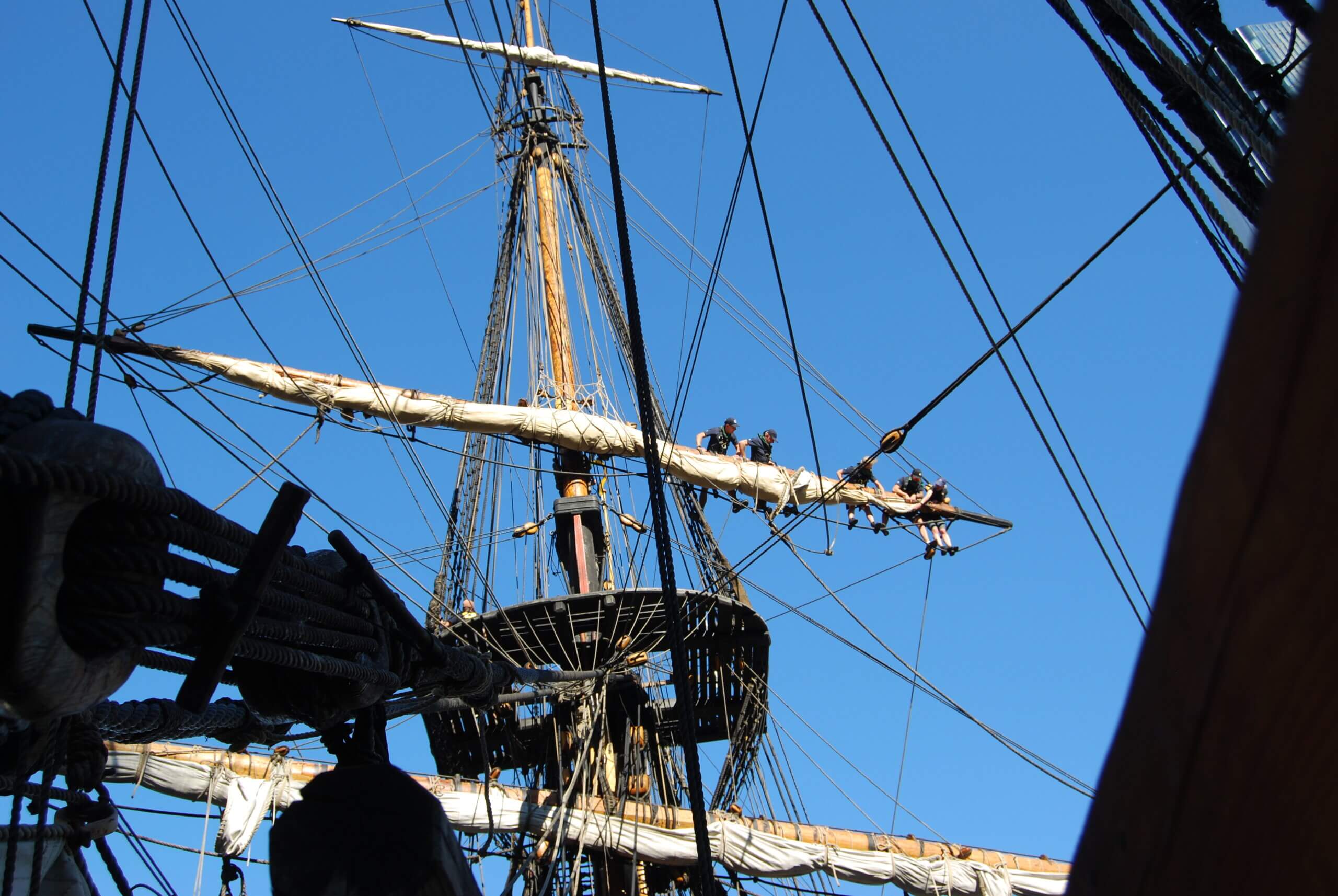When we went to Gothenburg earlier this year, we passed an 18th century ship moored up at one of the wharfs (as you do).

It wasn’t an actual 18th century ship but an reconstruction of a vessel that had sunk just outside Gothenburg in 1745. The wreck was excavated from 1986 to 1992 and the details discovered made it possible to build an exact replica (albeit one equipped with an auxiliary engine and the latest navigational aids). The ship, we learned, was open to the public, but only at weekends and we weren’t going to be staying long enough to see it. So when we learned that it was turning up in London on a stop on its voyage to Asia, we went along to have a look. (Why Asia? The original ship was owned by the Swedish East Indies Company and traded between Sweden and China.)
The vessel was parked up (OK, moored) in Canary Wharf, its 18th century lines a start contrast with the buildings around it.

Although new technology has been fitted to make the ship safe (much of it a legal requirement these days) the vessel still relies for the essentials on 18th century engineering. So steering is through a steering wheel connected to the rudder by rope. There is no hydraulics or mechanical assistance and in heavy weather several crew members will be holding the wheel to keep the boat on course. I was interested to see that, unlike in every film I’ve ever watched, the steering wheel was not on the poop deck but down below and the helmsman had no actual sight of the direction the ship was headed, relying entirely on a compass. Interestingly, a replica compass is alongside the wheel and above it there is a modern electronic indication of the ships bearing. There wasn’t a lot of difference between the two but, given that a lot of the navigation was by dead reckoning the couple of points that the magnetic compass was off must have meant that the ship was often not exactly where it thought it was. No wonder that shipwrecks were so common.

The ship was armed with an assortment of cannon. You can visit the gun deck with its reproduction weapons. All of those on board these days are six-pounders. They are regularly used for saluting as the ship enters port, although they are triggered electrically rather than by lighting the powder with a flame. We were assured that the Canon would always have been principally used for signalling rather than defence . Having written (in The White Rajah) about piracy in the South China seas , I must admit I thought this was a rather sanitised view of the historical reality. Perhaps Gothenburg just got lucky – or perhaps pirates took one look at the gun ports and decided to attack someone else.


The crew used to eat on the gun deck, and they still do. You can see the tables and benches either side of the guns. When the guns are being used the benches and tables swing up and are secured against the hull out of the way.
We couldn’t see the crew’s cabins (below the gun deck, where the cargo used to be carried). I suspect these are not accurate replicas of the way that the crew used to live back in the 18th century. There was the odd hammock on the gun deck, which is where the crew would have slept originally.
You can admire the navigation and listen to the stories about how the crew would have shared their accommodation with a cow but I imagine that for most people the most impressive thing about a ship like this is the rigging. When we were there we watched people having their first experience of going aloft. (The Gothenburg takes on new crew at every port.) There’s no modern technology to help with hoisting and lowering sail, although there are safety lines and the crew wear a harness. Even with a harness, you’re not going to get me up there in a hurry (or ever). It was impressive, though, to watch people start up visibly nervous and by the time they were making their way along the spar, most of them looked surprisingly relaxed.


Fascinating as our glimpse of life on board was, the most striking thing about the ship, to a 21st century eye, is just how beautiful she is.



The White Rajah
My book about a British merchant adventurer’s travels to the East Indies is set around a hundred year’s after the working life of the Gothenburg but the vessels then would have been very similar. There were pirates preying on the ships and James Brooke (my real-life hero) was involved in efforts to reduce the danger they posed to shipping. His six-pounder cannon proved useful on land too, as he got caught up in local politics and found himself taking sides in civil war. This (mostly) true story is a must-read for anyone interested in the reality of the early days of trade with the East Indies. It’s available on Kindle, in paperback and even in hardback.



My wife and I visited on Tuesday. I mentioned the headroom to one of the crew (I’m tall but didn’t have to stoop). They said that it’s not got an authentic deck spacing, at least one deck was left out so the headroom complied with reasonable modern standards.